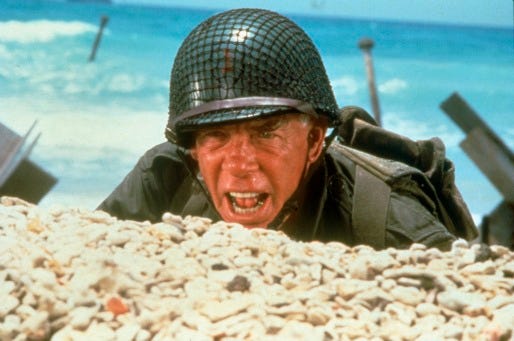The Big Red One (1980)

"This is fictional life Based on factual death."
So writer/director Samuel Fuller announces at the beginning of "The Big Red One," a World War II picture based largely on his own experiences as a soldier with the Army's 1st Infantry Division. As Fuller showed with "The Steel Helmet," he had a great flair for war stories that swell with a grizzled sort of authenticity.
Fuller had been trying to make the movie since the 1950s and actually began scouting some locations until he butted heads with mogul Jack Warner. He had to wait another quarter-century before "Red" came out in 1980.
I think the wait probably served the film better, giving it more distance and perspective from the events portrayed in it, which span 1942 to 1945 and most every front of the war in Europe from North Africa, Sicily, D-Day, France, Belgium, the invasion of Germany and the liberation of a Czechoslovakian concentration camp for Jews.
The delay also helped with the casting of the leading man, the gruff and taciturn Sergeant (no name ever given, or needed). The studio wanted to cast John Wayne, who no doubt would have insisted on a more purely heroic role — sort of what he did in the underwhelming "Sands of Iwo Jima."
Instead, Fuller was able to cast Lee Marvin, whose steely countenance and gravel-pit voice is a perfect fit for the war-blasted commander of a rifle squad. Marvin fell backwards into acting, doing bit parts and villain roles, then became an unexpected leading man in his 40s and 50s.
If anything, at times Fuller makes Sarge a little too tough and unlikeable. I think of a scene where a green recruit steps on a tripwire and sets off an explosion. As the stunned man struggles to maintain consciousness, his flesh scorched and his body torn, Sarge blithely tells him the tripwires are not meant to kill, just castrate. He reaches down to the man's nethers, pulls up a horrific bloody pulp of flesh, and tells the kid it's one of his testicles. "That's why God gave you two," he barks, heaving the valuable piece anatomy over his shoulder like dog scraps.
"The Big Red One" has a deliberately episodic feel, concentrating on Sarge and his Four Horsemen, as the battalion commanders name the quartet of infantrymen who survive with him through every stage of the war. They are survivors, careful killing machines who know how to take life while preserving their own. The new recruits arrive and die so quickly, the core group doesn't even bother to learn their names.
Mark Hamill, in between "Star Wars" movies, had one of his more substantive roles as Griff, a marksman who is reluctant to kill, dubbing it "murder." Sarge tersely explains that if you've got generals giving orders and a piece of paper declaring it war, then it's simply killing. He should know, having accidentally murdered a German at the end of the last war four hours after armistice had been declared.
The movie is quite explicit that one of Sarge's jobs is to shoot any man who refuses to do his duty, and there's an amazing scene during the depiction of D-Day where he actually takes a few shots at Griff as a warning. Griff is all alone on the beach, pinned down by enemy fire, trying to blow a break in the barbed-wire barricade using a bangalore torpedo. A half-dozen others have already died, and when Griff freezes up, it's clear Sarge is not above adding another to that number, even if it's one of his Four Horsemen.
Robert Carradine is the narrator as Zab, a brash young writer constantly chewing on a cigar, who clearly acts as a stand-in for Fuller himself. There's a harrowing scene where Zab crawls across a line of dead men to bring news to the colonel and pauses over the corpse of one man whose guts are splayed all over the place. His face almost touching the dead man, Zab calmly pulls a fresh cigar out of the man's pocket to replace his own sodden one.
Less prominent roles go to Bobby Di Cicco as Vinci, a loudmouth Italian, and Kelly Ward as Johnson, a farm boy with hemorrhoids.
In his review of the movie, Roger Ebert called "The Big Red One" the most expensive B-movie ever made, noting that A-war films are always about the war, while B-war movies are about the soldiers. I'd disagree with that; "Saving Private Ryan" is clearly about the soldiers, and could hardly be called a B-picture. Both films have similar themes about the bonds that men form during the horrors of battle.
Ultimately, they fight to survive and they fight for each other, not for a vague concept of "war." In his narration, Zab admits that they never understood what the war was really about.
"The Big Red One" was edited down considerably in its initial release, but today is available in an uncut version approaching three hours in length. It never feels like the movie dawdles, even as it sprawls over months and years of the war's progress. My only complaint might be the undue prominence of Siegfried Rauch as Schroeder, a stalwart German soldier who has several encounters with the squad (unbeknownst to them).
It's all setting up a final encounter that mirrors the opening one in which Sarge stabbed a German to death after the war was officially over. Upon realizing Schroeder is still alive, the squad patches him up and saves his life, which Zab dubs the biggest joke of the entire unfunny war.
"The Big Red One" has been called one of the forgotten great war movies. I think that's overpraising it, but it's certainly a worthwhile and offbeat take on the genre.
4 Yaps



